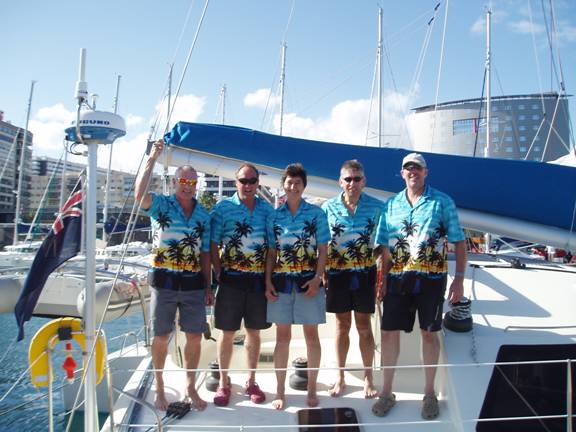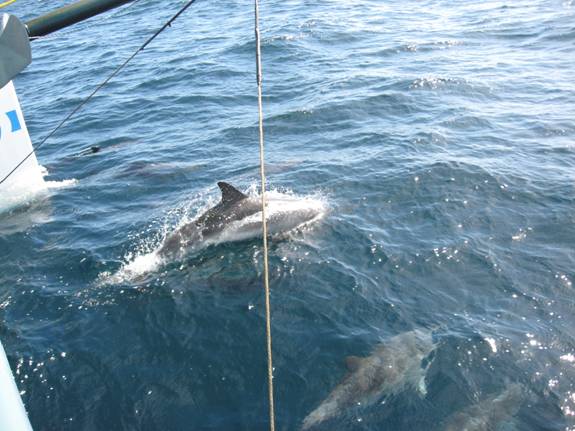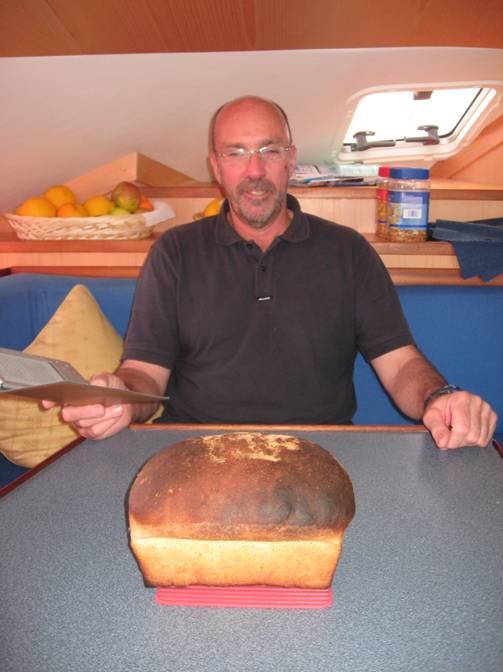THE TRANS-ATLANTIC CROSSING

|
The trans-Atlantic crossing Well, we made it, and after a week in The 10 days leading up to the start saw more yachts and
their crew gather in About to leave Las Palmas.The team in tropical crew
shirts: Martin, Me, Lucy, Bill and Keith The start was mayhem. The ‘racing’ division started 20
minutes before the main fleet. The start was, for the technically minded, run
under International Collision Regulations and not the Racing Rules. This allowed
us to keep our engines running which was just as well and a significant number
of boats did not have a clue what was going on. We had to drive out of more than
one collision situation. Once started we very quickly pulled away from the
majority of the fleet. We overtook our main multihull protagonist, ‘Papillon’
after about 20 minutes and then we settled into the rest of the day and first
night with only the large 60+ ft. yachts for company
Sailing away from the fleet at the
start We changed from the Code 0 genniker to the spinnaker and
really set off with a vengeance and just 3 hours after the start clocked a new
fastest speed for the boat of 20 knots!
Concentrated sailing after the start- it didn’t last
long! That first night we settled into the routine of dropping
the spinnaker and using the Code 0 genniker. It is not quite for quick but is
much easier to sail with in the dark. On the first night we were surrounded by other boats,
but by morning most had disappeared and from then on if we saw one boat a day if
we were lucky. Over the next few days we settled into the routine of
watch-keeping -3hours on and 3 off at night and 4 on – 4 off during daylight. As
only Martin had sailed on Snow Leopard before it took a while for them to get to
know the boat. Winds were already frustratingly light and we continued
to head more south then west to seek better winds. This was the pattern of the
next few days as we made out way down to just west of the Marine life stepped in to entertain us. We had one huge
pod of Striped Dolphin keep us company for hours, and at night the first flying
fish came aboard. These proved to be dangerous later on when Keith got hit three
times by kamikazi flying fish in the middle of the night!
Our
first flying fish on board For the first week the wind remained frustratingly light
and from the east making it very difficult for us to sail directly downwind
towards Life on board had settled down to a routine of
watch-keeping, sleeping and eating with a few special moments to keep us amused.
One was Keith’s first attempt at bread-making (with a little help from Lucy).
Here is the proud man with the result of his endeavours
Fishing started to take on more importance, but at the
speed we were travelling only sea monsters would take our bait of lurid
fluorescent orange plastic squid – and they did, three times! Unfortunately they
snapped the line and disappeared most of our fishing tackle. So we were reduced
to a reel of light rope with a lure tied onto it and that did the trick. We
landed a decent sized fish, we think it is a Whahoo (if anyone knows better
please tell us). It was expertly filleted by James and we enjoyed Whahoo sushi
marinated in lime juice for lunch and large fillets in a teriyaki sauce for
dinner
On the 5th day we finally got some decent
breeze with 20knots from the NNE. With one reef in the main and the spinnaker we
did a 24-hour run of 240 miles –an average speed of 10
knots! However this did not last long and we spent the next few
days searching for wind and trying to avoid squalls. We were not very successful
at either. Our track over these days looks like that taken by a crazed skipper
meandering all over the mid-Atlantic (which may have a ring of truth to it) and
we got caught in an enormous rain storm which lasted for about two
hours
Radar picture at centre of torrential rain storm – red
means heavy, heavy rain! Otherwise we continued with very gentle sailing,
occasionally motoring at night when there was no wind (we don’t carry that much
fuel so we had to be judicious with our motoring.)
Finally, after yet another boat of rain squalls we got
into some decent settled trade winds about 500 miles east of St. Lucia and
really began to make fast progress, hitting a new maximum of 20.8 knots, claimed
by Bill as he was on watch, but he had little to do with it as the boat was on
auto pilot at the time (as it was for 99% of the crossing)
Our
fastest speed yet – 20.8 knots With all this speed something had to give and it was the
outer end of the bowsprit holding the asymmetric spinnaker. A weld gave way and
tore the stainless steel end cap. Hurried repairs, by Bill using all his rigging repair
experience and we were soon on our way again
Running repairs to the spinnaker
bowsprit We could almost smell We downed sails and motored into the lagoon and our
marina berth. We were given a rapturous welcome even at that time in the
morning. We were presented with rum punches and a big basket of fruit. It may
have been a slow crossing in 17 days (we were anticipating 12 -14 days), but we
were still 13th boat to finish, beaten by big 60 -80 ft boats, and we
were the first multihull by nearly 24 hours! Well done to all the crew
Our
night-time arrival in St.Lucia
A
rum-bustuous welcome from Joe of the
Next day after a few hours sleep, with all formalities
completed we were ready to enjoy the hospitality of
View from our masthead
Local marine fruit seller! |
















